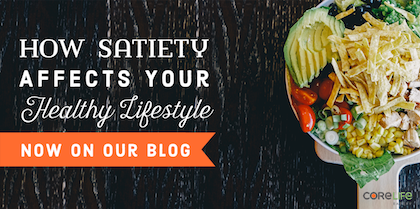As a dietitian nutritionist, one of the most common questions I get asked is,
“What do all people with a sustained healthy lifestyle have in common?”
Some things that come to mind are discipline, motivation, and organization – all of which serve a healthy lifestyle very well. However, the one thing that’s common amongst all is this: satiety.
Satiety is defined as the feeling of being full or satisfied after eating, and is arguably the most significant factor in a sustained healthy lifestyle. Let’s be honest, feeling hungry and deprived is a one-way ticket to falling off the bandwagon. Consider this: how successful would you be with your physical health goals if you always felt 100% satisfied with your healthy food choice? Temptation would dramatically decrease, your cravings for junk would be gone, and your desire for more goodness would flourish. Now, if that doesn’t scream RESULTS, I don’t know what does!
So, what’s the secret? How can one feel ‘satiated’ while making healthy choices? The answer has less to do with counting calories and portion control, and more to do with the multi-sensory food experience; including nutrient content, food source, flavor, texture, and overall mindfulness.
Nutrient Components
- Fiber. Research has shown that fiber intake can reduce appetite and overall energy intake, thereby promoting weight-loss. Fiber-rich foods also tend to require more chewing which triggers our brain towards a more ‘satisfied’ state. To amp up your daily fiber intake, choose whole-food fiber sources including veggies, fruit with the skin or peel on them, beans, and non-processed whole grains such as wild rice, quinoa, or farro.
- Water naturally occurring in foods is one of the best ways to ensure feeling satisfied and full. Research has also suggested that our body absorbs this coveted hydration best from whole-food sources rather than just chugging water from a bottle. Moral of the story? The more nutrients in the produce, the merrier! Most vegetables comprise more than 80% water, with greens like spinach and kale being the frontrunners. Fruits are generally 80-90% water, with berries being a top choice for their beneficial antioxidants and phytonutrients.
- Fats are generally digested slower than other key nutrients, which allows you to feel full for a longer period of time. The key here is to choose at least one healthy fat source at each meal that will nourish your body well. Ideas would include topping a dish with avocado or guacamole, using grass-fed butter, ghee, or coconut oil to cook or top a dish with, or drizzling a salad with a flavorful dressing made with a wholesome olive oil, grape-seed oil, or avocado oil. Increasing healthy fat intake while simultaneously decreasing refined carbohydrate and sugar intake not only makes us feel more satisfied, but actually promotes our bodies fat-burning potential.
- Protein. Much like fat, protein allows us to feel fuller for longer. The goal is to get between 20-30 grams of protein at each meal to allow for sustained satiety throughout the day. A few examples of what 20-30 grams of protein looks like includes
- 3-4 ounces of beef, chicken or turkey
- 4-6 ounces of fish
- hearty combination of plant-based proteins such as beans, nuts, and wholesome grains.
But, it’s important to remember that not all protein is created equal. One of the most important factors in protein is the source…AKA where it comes from and what it eats.
Take-home message: The more processed your food is, the less satisfying it will be. Choose whole, non-processed foods including quality protein sources, fruits, vegetables, healthy fats, and unprocessed whole grains for optimal wellness.
Food Source & Quality
It can seem strange to think that where our food comes from can have such a significant impact on our satiety. You are not only what you eat; you are what your food eats.
Research shows that in a group choosing grain-fed vs. grass-fed beef, those eating the higher quality grass-fed ate a significantly less quantity at a given meal. Why? Because it was more flavorful, has higher nutrient density boasting high omega 3’s and inflammation-fighting components called conjugated linoleic acids (CLA’s), and therefore is overall more satisfying. Furthermore, grass-fed beef has less overall calories and less fat per ounce compared to grain fed beef, which translates to lower overall intake, but increased satisfaction. Simply making the switch to quality protein can shave off thousands of calories and several pounds each year. Now that’s a recipe for success!
Mindfulness
I know this may come as a shock, but we don’t always eat just because we’re hungry. Reasons for eating other than hunger may include a wide range of emotions (stress, happiness, sadness, etc), social occasions, addiction, or the appeal of the food itself (have you ever eaten dessert when you’re already ‘stuffed’?)
Being mindful regarding food is ultimately the only way we can gauge if we feel satisfied, and therefore is the cornerstone of satiety.
I challenge you to consider what your ‘full’ feels like. Do you fully experience your food; the flavor, the texture, the sights and smells? Take meals as an opportunity to break away from the hustle and bustle. Enjoy your food, and immerse yourself in meaningful conversation, rather than technology. I encourage you check out this group’s meaningful journey towards mindfulness and how it significantly impacted their physical well-being and lives beyond. My hope is that your food journey is fulfilling, rich and satisfying. Happy Eating!

